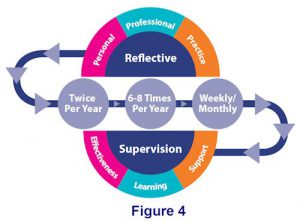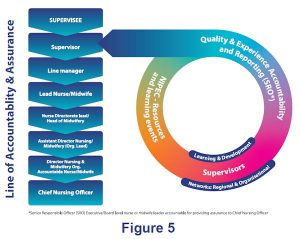 Reflective Supervision:
Reflective Supervision:
Purpose:
- To enable supervisors and supervisees to prepare for and acknowledge their role within the reflective supervision process
- To provide a guideline for organisations to ensure effective implementation
- To guide the development of education programmes for reflective supervision focusing on agreed best practice
- To provide service users and the public with a contemporary description of the standards for reflective supervision
-
Who:
Who:
- A Supervisor of Nurses or Midwives must be a NMC Registered Nurse or Registered Midwife
- A Supervisor should have a minimum of three years experience as Registered Nurse or Registered Midwife
- Supervisors must as a minimum have undertaken a Supervisor Preparation Programme
- A supervisee is a NMC Registered Nurse or Registered Midwife. They should participate in two formal Reflective Supervision sessions per year
- The Supervisee should choose an appropriate Supervisor from the organisation’s list and agree this with their line manager
-
Ratio:
Ratio:
- The number of reflective supervision sessions that an individual supervisor makes available in a financial year is 1:16 supervisor: reflective supervision sessions annually
- This number relates to sessions not people, for example, if a supervisor has three people who need supervised four times per year they should only provide four more ‘sessions’ for reflective supervision to others
- Where a group session is provided – described in guidance as up to two hours – this will count as two sessions where one session is defined as spanning approximately one hour in length of time
- Where a supervisor works part time hours an agreed pro-rata ratio will be established with his/her line manager
-
Frequency:
Frequency:
- For each registrant there should be a minimum of two opportunities per year for reflective supervision in individual or in group in format (can be a mixture of both)
- The mode and/or frequency of reflective supervision will change depending on circumstances (Figure 4)
Click here for the guidance relating to frequency of Reflective Supervision based on escalation of risk in practice, which also includes the type of reflective supervision accessed, confidentiality, appropriate choice of environment, responsibilities, boundaries and the agreement of ground rules between the parties.

-
Confidentiality:
Confidentiality:
- Confidentiality is pivotal to the success of supervision and respectful, trusting relationships should be maintained
- Supervisors and supervisees should adhere to the responsibilities articulated within the framework acknowledging trust and expectations
Click here for the guidance which also includes appropriate choice of environment, responsibilities, boundaries and the agreement of ground rules between the parties
-
Organisational Infrastructure
Organisational Infrastructure:
- Value and priority should be placed on the process of reflective supervision by the organisation at Board level through an organisational Responsible Officer who is a nurse or midwife
- Each organisation should have a structure identified to support organisational accountability, aligning with existing governance and escalation processes to include raising and escalating concerns
- For the purpose of HSC Trusts the Responsible Officer will be the Executive Director of Nursing or in other organisations a nurse or midwife who is of a similar level of seniority




